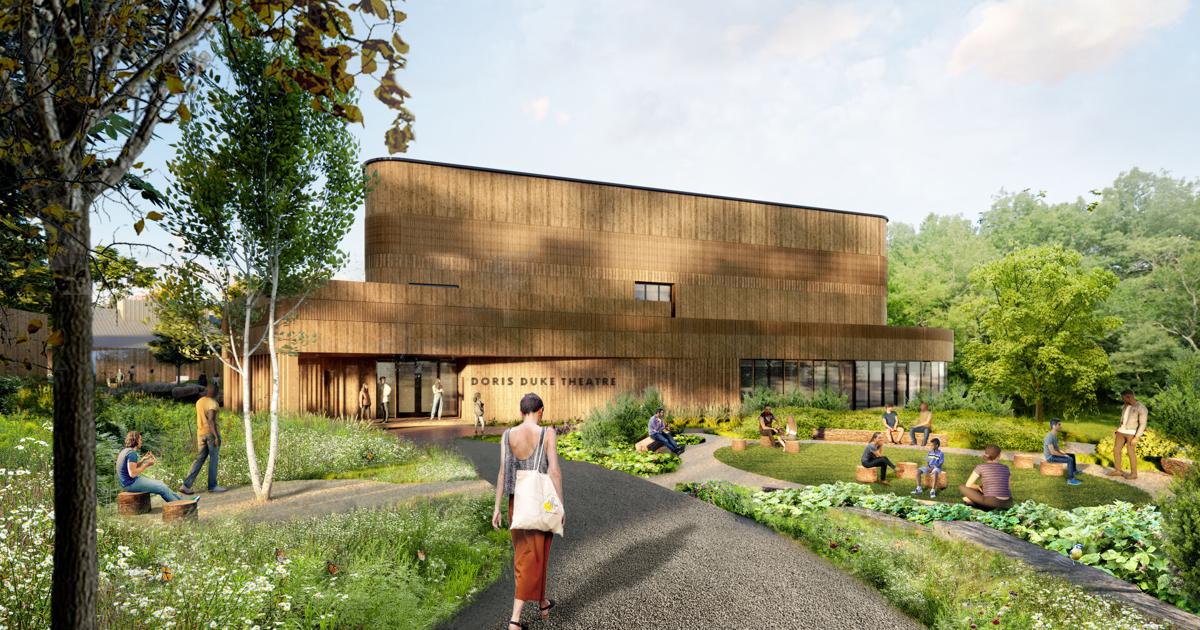
As seen in an architectural rendering by a design team that includes Francine Houben, founding architect of Mecanoo.
BECKET â Four years ago, when a fire destroyed the Doris Duke Theatre at Jacobâs Pillow, Artistic Director Pamela Tatge knew she had to turn the horrible loss into an opportunity.
âWe took something that was the ultimate tragedy â the loss of a theater that had served audiences and artists for 30 years â and decided to build a theater deeply grounded in the Earth and equipped for the future,â Tatge said.
This coming summer, on July 9, the Pillow will swing open the doors of its new Doris Duke Theatre, kicking off seven weeks of programming with a focus on performances that utilize emerging technology, including artificial intelligence and robotics.

“It has the potential to provide access to dance, and art, in ways that weâve never seen before,” Pamela Tatge said of the streaming capabilities in the new Doris Duke Theatre, seen here in an architect rendering.
âThe Duke will be equipped to host works at the intersection of dance and technology, which is a direction that many artists are going in,â Tatge said. âThereâs a real need for space to both create those works and present them.â
At 20,000 square feet, the venue is nearly three times the size of the former Doris Duke Theatre, which opened in 1990. It also is able to livestream performances, and has flexible stage and audience configurations, and is able to seat anywhere between 220 and 400 audience members. This stands in stark contrast to the Pillowâs two other venues, both of which are proscenium spaces: the Ted Shawn Theatre, with over 600 seats, and the outdoor Henry J. Leir Stage, which seats up to 400.
âWe are under pressure to select [dance] companies that can fill the Ted Shawn Theatre for six performances, 635 seats per performance,â Tatge said. âWhereas with 235 in the new Duke, thereâs much more space for experimentation and to introduce emerging and early career artists.â
The organization worked with Mecanoo, a Dutch architecture firm, and the company’s founding architect, Francine Houben, as well as landscape architecture film Marvel, theater and acoustics consultants Charcoalblue and Cherokee artist Jeffrey Gibson, currently represented at the Massachusetts Museum of Contemporary Art with âPower Full Because Weâre Different,â to build the theater, as well as new outdoor spaces including a garden with native and medicinal plants. Fundraising is ongoing for the campaign which includes the new theater, as well as the outdoor areas, and an associated endowment. Funds to date have come from an insurance settlement, individuals, state agencies, and foundations, including a lead gift of $10 million from the Doris Duke Foundation.
âThe building itself is really made to incorporate indigenous design principals and values,â Tatge said. âOur architect wanted us to really connect with the environment that gives Jacobâs Pillow its quintessential identity, so the doors open up to the outdoors, and you can have a performance start outside and move inside.â
Such is the case for âVástádus eana â the answer is land,â a piece that, in its performance at the Doris Duke Theatre, will mark the U.S. debut of indigenous Sámi Norwegian choreographer Elle Sofe. âItâs about honoring the land on which we exist and becoming one with it,â Tatge said.
Another piece that will be staged at the Duke this summer, Faye Driscollâs âWeathering,â is also about the surrounding land.
âIt really grounds us in our present environment,â Tatge said. âThere is absolutely a feeling of the effect of climate change, and what it will mean to us.â

âThe outpouring of memories, of love and support, has been remarkable and has only fueled our determination to build back better, as they say,” Pamela Tatge said in November 2021, a year after a fire destroyed the original Doris Duke Theatre.
Additionally, Tatge has programmed four tech-forward pieces at the Duke.
In his world premier âHERE,â interactive electronics dance and theater artist Andrew Schneider uses spatial sound, a technology that can make it seem like sound is coming from various directions and distances.
âInstead of having sound emanate from certain positions, it can emanate from anywhere because of how itâs projected into the space,â Tatge said.
âTouch of REDâ by Shamel Pitts, a 2020 Pillow Lab resident, âis really about the intersection of two bodies and a project that happens around the work, on the floor and above the work,â Tatge said. âThe projected film frames the performance in very exciting ways.â
Eun-Me Ahn developed her work âDragonsâ during the pandemic, when she couldnât bring dancers together in physical space. âShe found a 3D holographic technology wherein dancers could be represented in the performance, but not in reality, so the dancers onstage dance with the 3D holograms.â
Finally, Huang Yi, a dancer/choreographer and robotics inventor, makes his Pillow debut with a work that includes not only live human dance but two robots.
âThey look like industrial machines but they have an appendage that the dancer dances with and between and among,â Tatge said.
As for the rest of Yiâs piece, it includes floor-to-ceiling projections where dancers dance with calligraphic images.
âItâs this kind of immersive experience where the dancers are triggering projections in front of your eyes, so thereâs a real dialogue between that visual image and the body.â
Tatge hopes that with proper funding, the Duke will be able to have a nine-week season in 2026, continuing a mix of tech-forward pieces and ones that ârequire a more intimate relationship between artist and audience member,â as Tatge said. âThere will always be a balance.â

